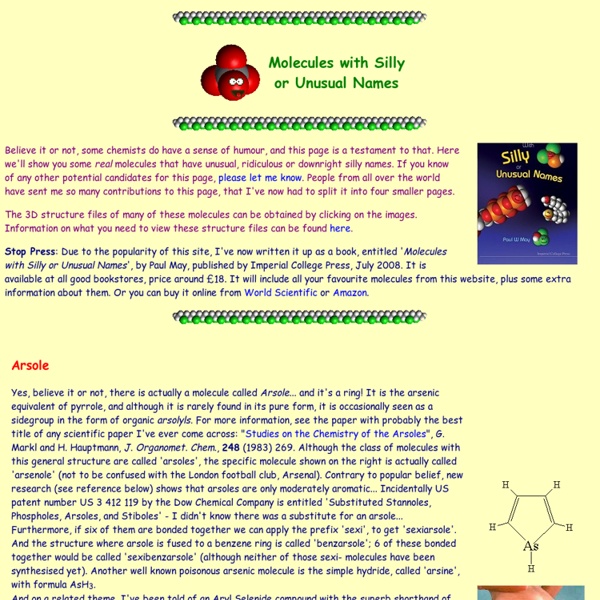Molecules with Silly or Unusual Names
Arsole Yes, believe it or not, there is actually a molecule called Arsole... and it's a ring! It is the arsenic equivalent of pyrrole, and although it is rarely found in its pure form, it is occasionally seen as a sidegroup in the form of organic arsolyls. For more information, see the paper with probably the best title of any scientific paper I've ever come across: "Studies on the Chemistry of the Arsoles", G. Thanks to Neil Brookes, Nicholas Welham, Andy Shipway, Lloyd Evans, Peter Sims, John Perkins, Bob Buntrock and Ben Mills for some of the info and details about these molecules.
WebElements Periodic Table of the Elements
Nomenclature Made Practical: Student Discovery of the Nomenclature Rules - Journal of Chemical Education (ACS Publications and Division of Chemical Education)
Abstract The chemical nomenclature of inorganic compounds is typically introduced early in many introductory chemistry courses at both the university and secondary school levels. From the perspective of the student, chemical nomenclature is a series of complex rules and situations involving unfamiliar concepts, such as, transition-metal oxidation states and polyatomic ions. Citing Articles View all 2 citing articles Citation data is made available by participants in CrossRef's Cited-by Linking service. This article has been cited by 2 ACS Journal articles (2 most recent appear below). Using Product Content Labels To Engage Students in Learning Chemical NomenclatureM.
Science Humor Webring - history
[ Visit the ring | Join the ring | Nominate a site for the ring | Report problems with the ring | Information for ring members] [The beginning] [1999 till August 2000] [Yahoo! Webring integration] [Split rings] The Beginning [ Prehistory | Creation | The first three months ] This page describes how I created the Science Humor webring, how I tried to get people to join the ring and what the results of those action were. The prehistory of the Science Humor Webring As usually the history of a ring starts with a website, in this case my Science Jokes list, which has its own history. This story starts with me travelling around a science fiction ring, moving to the list of sites and accidently selecting the homepage of Webring.org. Looking under science did not give me anything, under humor were so many rings that I gave up, but webring also has a search engine and that found me a Fun Science ring. So, my site did not fit any ring. The next day, I had a reason to make a ring. The search engines
Nanoputian
NanoPutians are a series of organic molecules whose structural formulae resemble human forms.[1] James Tour et al. (Rice University) designed and synthesized these compounds in 2003 as a part of a sequence of chemical education for young students.[2] The compounds consist of two benzene rings connected via a few carbon atoms as the body, four acetylene units each carrying an alkyl group at their ends which represents the hands and legs, and a 1,3-dioxolane ring as the head. Tour and his team at Rice University used the NanoPutians in their NanoKids educational outreach program. Construction of the structures depends on Sonogashira coupling and other synthetic techniques. "NanoPutian" is a portmanteau of nanometer, a unit of length commonly used to measure chemical compounds, and lilliputian, a fictional population of humans in the novel Gulliver's Travels. Background[edit] NanoKids Educational Outreach Program[edit] The main characters in the videos are animated versions of the NanoKid.
Apples & Chalkdust
Famous Scientists - Revolutionaries Visionaries Futurists
Evernote
Related:
Related:



